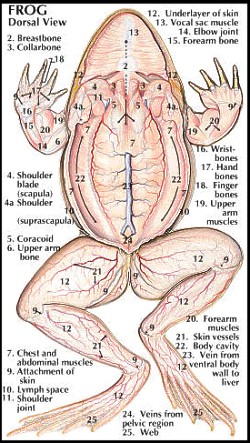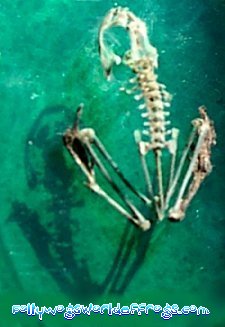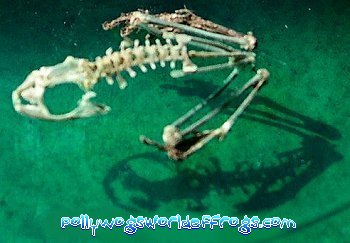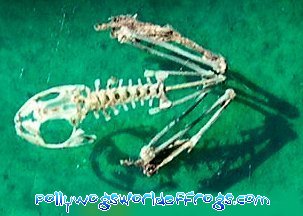Frog Glossary A
Acinetobacter:
Acinetobacter baumannii is a pleomorphic aerobic gram-negative bacillus .
It is a water organism and preferentially colonizes aquatic environments.
A baumannii is a multi-resistant aerobic gram-negative bacillus sensitive to
relatively few antibiotics. Multi-drug-resistant Acinetobacter is not a new or
emerging phenomenon, but A baumannii has always been an organism inherently
resistant to multiple antibiotics.
Advertisement call: This is the sound produced by male frogs and
toads during the breeding season in order to attract females of their same species.
Aerobic: Relating to oxygen, needs air to survive.
Motile in air, 'With' air, etc. See also Anaerobic.
 Aeromonas: A genus of anaerobic, flagellated
gram-negative, rod-shaped bacteria which are of freshwater origin and infect chiefly cold-blooded animals.
The best known-infection is 'red leg' in frogs. In humans, wound infections may occur
following contact with the contaminated water or soil. Also affects humans by causing diarrhea.
Aeromonas species have also been reported to cause infections such as septicaemia,
endocarditis, osteomyelitis, myonecrosis, haemolytic uraemic syndrome, meningitis,
peritonitis, respiratory tract disease and ocular infections. In addition to humans,
they are also important pathogens in amphibians, reptiles and fish, causing major
problems in fish farming. Aeromonas species have also been isolated from a variety
of foods such as vegetables, raw milk, ice cream, meat and seafood.
Aeromonas: A genus of anaerobic, flagellated
gram-negative, rod-shaped bacteria which are of freshwater origin and infect chiefly cold-blooded animals.
The best known-infection is 'red leg' in frogs. In humans, wound infections may occur
following contact with the contaminated water or soil. Also affects humans by causing diarrhea.
Aeromonas species have also been reported to cause infections such as septicaemia,
endocarditis, osteomyelitis, myonecrosis, haemolytic uraemic syndrome, meningitis,
peritonitis, respiratory tract disease and ocular infections. In addition to humans,
they are also important pathogens in amphibians, reptiles and fish, causing major
problems in fish farming. Aeromonas species have also been isolated from a variety
of foods such as vegetables, raw milk, ice cream, meat and seafood.
Aeromonas hydrophila is found in all freshwater environments,
and can infect you through open scratches, wounds when you touch infected water.
 It can infect any wound, but persons with impaired immune systems due to illness or
medication are most susceptible to infection. Symptoms include pain, swelling, or
redness at the site, and possibly, fever and chill.
It can infect any wound, but persons with impaired immune systems due to illness or
medication are most susceptible to infection. Symptoms include pain, swelling, or
redness at the site, and possibly, fever and chill.
If you will be treating red leg in any of your frogs, make sure you have no cuts, wash your hands and arms with hot soapy water
after touching water, or wear elbow-length playtex gloves that you then soak in a
salt/bleach sterilize rinse.
Aestivation: A period of warm weather inactivity; often triggered by
excessive heat or a drought.
Agonistic behavior: The fighting behavior between members of the same species.
Allopatric: Not occurring together but often adjacent.
Ambient temperature: The temperature of the surrounding environment.
Amphibian: An animal that is considered cold blooded, and needs both land and water
in order to survive. Amphibians also possess 4 fingers on their front palms,
and 5 on their soles, or 'feet'.
Amplexus: The breeding grasp between two amphibians.

Anaerobic: Relating to a lack of air.
A condition in which air is not circulating and/or present. Can be caused in atmosphere by objects blocking the
path of wind, such as a low valley, a thicket or dense jungle, etc. Also relates to
lack of oxygen circulation in water.
Animal Kingdom: Frogs fall into categories within the animal kingdom. See Zoology
for more information.
Anura, or Anuran: One of three living orders (sometimes called salienta) of the class amphibia, which includes the frogs and toads.
 Anterior: Towards the front, usually referring to the body of the anuran
or other animal.
Anterior: Towards the front, usually referring to the body of the anuran
or other animal.
Anuran: Referring to frogs and toads of the amphibian family.
Anus: The external opening of the cloaca; otherwise known as the vent.
Aposematic: Refers to a brightly colored animal so as to warn predators of the animals' toxicity
or other danger that it may pose.
Arboreal: Referring to a tree-dwelling animal.

